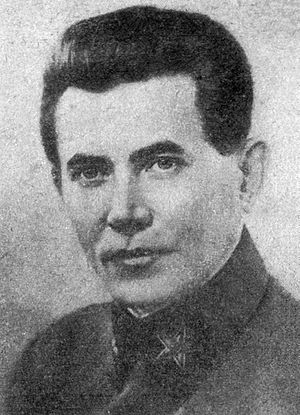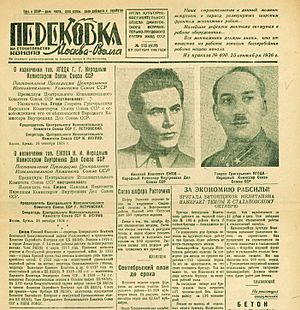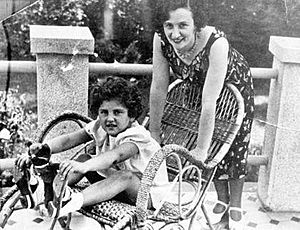Nikolai Yezhov facts for kids
Quick facts for kids
Nikolai Yezhov
|
|
|---|---|
|
Николай Ежов
|
|
 |
|
| People's Commissar for Internal Affairs (NKVD) |
|
| In office 26 September 1936 – 25 November 1938 |
|
| Premier | Vyacheslav Molotov |
| Preceded by | Genrikh Yagoda |
| Succeeded by | Lavrentiy Beria |
| Chairman of the Party Control Commission of the Central Committee | |
| In office 1935–1939 |
|
| Preceded by | Lazar Kaganovich |
| Succeeded by | Andrey Andreyev |
| People's Commissar for Water Transport (NKVT) | |
| In office 8 April 1938 – 9 April 1939 |
|
| Premier | Vyacheslav Molotov |
| Preceded by | Nikolay Pakhomov |
| Succeeded by | None (position abolished) |
| Full member of the 17th Central Committee | |
| In office 10 February 1934 – 3 March 1939 |
|
| Candidate member of the 17th Politburo | |
| In office 12 October 1937 – 3 March 1939 |
|
| Member of the 17th Secretariat | |
| In office 1 February 1935 – 3 March 1939 |
|
| Personal details | |
| Born |
Nikolai Ivanovich Yezhov
1 May 1895 St. Petersburg, Russian Empire |
| Died | 4 February 1940 (aged 44) Moscow, Russian SFSR, Soviet Union |
| Cause of death | Execution by shooting |
| Citizenship | Soviet |
| Political party | Russian/All-Union Communist Party (Bolsheviks) (1917–1939) |
| Spouses |
Antonia Titova
(m. 1919; div. 1930)Yevgenia Feigenberg
(m. 1930; died 1938) |
| Children | 1 (adopted) |
| Signature |  |
| Nicknames | Ежевика (Blackberry) Iron Hedgehog |
Nikolai Ivanovich Yezhov (Russian: Никола́й Ива́нович Ежо́в, IPA: [nʲɪkɐˈɫaj ɪˈvanəvʲɪt͡ɕ (j)ɪˈʐof]; 1 May 1895 – 4 February 1940) was a Soviet secret police official under Joseph Stalin who was head of the NKVD from 1936 to 1938, during the height of the Great Purge. Yezhov organized mass arrests and executions during the Great Purge, but he fell from Stalin's favour and was arrested, subsequently admitting in a confession to a range of anti-Soviet activity including "unfounded arrests" during the Purge. He was executed in 1940 along with others who were blamed for the Purge.
Early life and career
Yezhov was born either in Saint Petersburg, according to his official Soviet biography, or in southwest Lithuania (probably Veiveriai, Marijampolė or Kaunas). Although Yezhov claimed to be born in Saint Petersburg, hoping to "portray (himself) in the guise of a deeply-rooted proletarian", he confessed when interrogated that his father Ivan Yezhov came from a well-off Russian peasant family from the village of Volkhonshino. He worked as a musician, railroad switchman, forest warden, and as a housepainting contractor employing a couple of hired workers. His mother Anna Antonovna Yezhova was Lithuanian. Despite writing in his official biographical forms that he knew Lithuanian and Polish, he denied this in his later interrogations.
He completed only his elementary education. From 1909 to 1915, he worked as a tailor's assistant and factory worker. From 1915 until 1917, Yezhov served in the Imperial Russian Army. He joined the Bolsheviks on 5 May 1917, in Vitebsk, six months before the October Revolution. During the Russian Civil War (1917–1922), he fought in the Red Army. After February 1922, he worked in the political system, mostly as a secretary of various regional committees of the Communist Party. In 1927, he was transferred to the Accounting and Distribution Department of the Party where he worked as an instructor and acting head of the department. From 1929 to 1930, he was the Deputy People's Commissar for Agriculture. In November 1930, he was appointed to the Head of several departments of the Communist Party: department of special affairs, department of personnel and department of industry. In 1934, he was elected to the Central Committee of the Communist Party; in the next year he became a secretary of the Central Committee. From February 1935 to March 1939, he was also the Chairman of the Central Commission for Party Control.
Personal life
Yezhov married Antonina Titova (Russian: Антонина Алексеевна Титова), a minor Communist Party clerk, in 1917, but he later divorced her and married Yevgenia Feigenburg (Khayutina-Yezhova), a Soviet publishing worker and Chief Editor of USSR in Construction magazine who was known for her friendship with many Soviet writers and actors. Yezhov and Feigenburg had an adopted daughter, Natalia, an orphan from a children's home. After Yevgenia's and Yezhov's deaths in late 1938 and 1940 respectively, Natalia was sent back to a local orphanage and was forced to relinquish the Yezhov surname. Subsequently, she was known by the name Natalia Khayutina.
Head of the NKVD
A turning point in Yezhov's career came in 1934 when Stalin used the murder of the Bolshevik chief of Leningrad, Sergei Kirov as a pretext for further purges. Yezhov was chosen to carry out the task. He was then further promoted and ultimately appointed as head of the NKVD.
He became People's Commissar for Internal Affairs (head of the NKVD) and a member of the Central Committee on 26 September 1936, following the dismissal of Genrikh Yagoda.
Seeming to be a devout admirer of Stalin and not a member of the organs of state security, Yezhov was just the man Stalin needed to lead the NKVD and rid the government of potential opponents. Yezhov's first task from Stalin was to personally investigate and conduct prosecution of his long-time Chekist mentor Yagoda. Yezhov ordered the NKVD to sprinkle mercury on the curtains of his office so that the physical evidence could be collected and used to support the charge that Yagoda was a German spy, sent to assassinate Yezhov and Stalin with poison and restore capitalism.

Under Yezhov, the Great Purge reached its height during 1937–1938. 50–75% of the members of the Supreme Soviet and officers of the Soviet military were stripped of their positions and imprisoned, exiled to the Gulag in Siberia or executed. In addition, a much greater number of ordinary Soviet citizens were accused (usually on flimsy or nonexistent evidence) of disloyalty or "wrecking" by local Chekist troikas and similarly punished to fill Stalin and Yezhov's arbitrary quotas for arrests and executions. The Gulag population swelled by 685,201 under Yezhov, nearly tripling in size in just two years, with at least 140,000 of these prisoners (and likely many more) dying of malnutrition or exhaustion.
Final days
On 22 August 1938, NKVD leader Lavrenty Beria was named as Yezhov's deputy. Beria had managed to survive the Great Purge and the "Yezhovshchina" during the years 1936–1938. Earlier in 1938, Yezhov had even ordered the arrest of Beria, who was party chief in Georgia. However, Georgian NKVD chief Sergei Goglidze warned Beria, who immediately flew to Moscow to see Stalin personally. Beria convinced Stalin to spare his life and reminded Stalin how efficiently he had carried out party orders in Georgia and Transcaucasia. In a twist of fate, it was Yezhov who eventually fell in the struggle for power, and Beria who became the new NKVD chief.
Over the following months, Beria (with Stalin's approval) began to usurp Yezhov's governance of the Commissariat for Internal Affairs. As early as 8 September, Mikhail Frinovsky, Yezhov's first deputy, was relocated from under his command into the Navy. Stalin's penchant for periodically executing and replacing his primary lieutenants was well known to Yezhov, as he had previously been the man most directly responsible for orchestrating such actions.
Well acquainted with typical Stalinist bureaucratic precursors to eventual dismissal and arrest, Yezhov recognized Beria's increasing influence with Stalin as a sign that his downfall was imminent.
At his own request, Yezhov was officially relieved of his post as the People's Commissar for Internal Affairs on 25 November, succeeded by Beria, who had been in complete control of the NKVD since 8 September. He attended his last Politburo meeting on 29 January 1939.
Arrest
On 10 April, Yezhov was arrested and imprisoned at the Sukhanovka prison; the "arrest was painstakingly concealed, not only from the general public but also from most NKVD officers.
In his confession, Yezhov admitted to the standard litany of state crimes necessary to mark him as an "enemy of the people" prior to execution, including "wrecking", official incompetence, theft of government funds, and treasonous collaboration with German spies and saboteurs.
Trial
On 2 February 1940, Yezhov was tried by the Military Collegium, chaired by Soviet judge Vasiliy Ulrikh, behind closed doors. Yezhov, like his predecessor Yagoda, maintained to the end his love for Stalin. Yezhov denied being a spy, a terrorist, or a conspirator, stating that he preferred "death to telling lies".
After the secret trial, Yezhov was allowed to return to his cell; half an hour later, he was called back and told that he had been condemned to death. He was executed by firing squad on 4 February 1940.
Yezhov's body was immediately cremated and his ashes dumped in a common grave at Moscow's Donskoye Cemetery. The execution remained secret.
See also
 In Spanish: Nikolái Yezhov para niños
In Spanish: Nikolái Yezhov para niños




